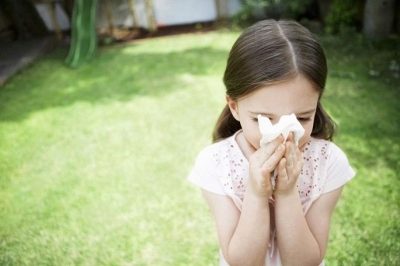Treatment of rhinitis in children folk remedies at home
Children due to the relative weakness of their immunity often suffer from a cold. Rhinitis can be called one of the most common children's ailments. Sometimes the disease has obvious reasons, sometimes the nose “lays” in a child who looks perfectly healthy, and besides a violation of nasal breathing, there are no other complaints. However, parents want to help the baby as soon as possible. It is not always possible to consult a doctor, because the polyclinics do not work on weekends and holidays. And to call an ambulance with complaints of a cold is not accepted.
It is unsafe and risky to prescribe medicines to the child on their own, especially when it comes to a small toddler. To help parents can come folk remedies that help get rid of the cold rather quickly.
Why does a rhinitis appear
A runny nose (rhinitis) is difficult to consider an independent disease, usually it is a manifestation of various disorders in the body. The nose stops breathing partially or completely with inflammation of the mucous membranes of this organ. Most often, this is a consequence of opposition to pathogens and viruses.
As you know, viruses enter the body mainly through the respiratory system. The nose is the first line of defense, most often, the invader viruses manage to go further - into the nasopharynx, into the larynx. In this case, the inflammation of the mucous membrane is an attempt of the body not to miss the harmful agent further.
The release of Dr. Komarovsky’s program on the causes and methods of treating childhood rhinitis can be viewed in the next video.
But the same influenza virus is inhaled by airborne by several people at once. But not everyone gets sick. A runny nose will start or not, depends not only on the state of immunity of the baby. The development of rhinitis is greatly contributed by various factors, such as dusty or polluted air, hypothermia.
There is another type of rhinitis - non-infectious. This includes nasal congestion with allergies (allergic rhinitis) and vasomotor rhinitis (associated with impaired processes in the autonomic nervous system). They arise somewhat differently, as a result of the narrowing of the lumen of blood vessels in response to an antigen or vascular nerve pathology.
Acute rhinitis - occurs as a reaction to a virus (less commonly - to bacteria). With it, the swelling of the mucous membranes is quite strong, and it affects both halves of the nose. With him, the child may experience increased tearing, redness of the wings of the nose and the release of liquid mucus, people say "flows from the nose."
If such a runny nose is treated incorrectly or not at all, after 3-4 weeks the process will become chronic. With it, the nose will remain stuffed for a long time, the child's smell will noticeably decrease, the discharge from the liquid will be transformed into thick, sometimes purulent, the mucous sometimes dries out, crusts form in the nasal passages.
Violations of nasal breathing in children occur in various diseases:
- SARS and flu.
- Scarlet fever.
- Measles.
- Allergy.
- Vegetative dystonia.
- Palatine tonsil overgrowth (adenoids).
- Other diseases.
A runny nose in a child can easily, or may be accompanied by fever, decreased appetite, headaches, and severe general weakness. What exactly the symptoms will accompany rhinitis, can not be predicted, all purely individually.
When folk methods can not do?
A runny nose in itself is not dangerous for the child. But its consequences can be quite serious. it sinusitis, sinusitis, meningitis, inflammatory processes in the inner ear, and as a result - complete or partial hearing loss, encephalitis and a number of other unpleasant diagnoses. And because there are some indications for immediate treatment to the doctor when rhinitis:
- If the nasal discharge in a child has a gray-green or green color and a very unpleasant smell. This may indicate a severe bacterial infection. This condition requires the early appointment of antibiotics.
- If, in addition to the cold, the child has pains in the frontal area, under the eyes, in the area of the nasal sinuses. This may be a symptom of sinusitis, inflammation of the hearing. In this situation, the child needs not onion drops in the nose, but serious therapy with the use of antimicrobial agents, hormonal and anti-inflammatory drugs.
- If, after a head injury or a fall, the child has a stuffy nose and a clear liquid discharge.should urgently take him to the hospital! Such symptoms may indicate a breach in the activity of the brain, such a condition requires early examination and hospitalization.
- If in the discharge of mucus in the common cold in a child there are visible impurities of blood, nodule or clots. This may indicate the traumatic nature of rhinitis, a foreign body in the respiratory organs, it is required to examine the baby as soon as possible.
Effective folk remedies
In most cases of acute infectious rhinitis, a child can be quite effectively helped with the use of alternative medicine.
Fresh Vegetable Juices
The most popular way to quickly heal the nasal congestion is to drop onion juice to the child. To do this, rub the onion on a fine grater, squeeze the gruel out with a piece of gauze, and dilute the resulting juice in half with saline or boiled water. Onion drip can be from 2 to 6 times a day.
Such a recipe is not suitable for children who have not yet turned 2 years old, since onion juice, even diluted, acts quite aggressively and can cause burns to the delicate mucous of babies. Children over 5-6 years old can add some honey in onion drops, this will have an additional anti-inflammatory effect.
Children under 2 years old can be careful to drip beetroot or carrot juice into their noses. To do this, use a juicer or a fine grater and a piece of gauze to squeeze out the juice, dilute it with boiled water in half, and drip 1-2 drops into each nasal course up to 5 times a day. When burying babies can choke, it is better to lay small cotton wool cups dipped in beet juice in both nasal passages.
Oil mixtures
Good effect in the common cold give drugs that will gently act on the nasal passages. These include mixtures that include oil - sunflower, flaxseed, petroleum jelly.
A popular recipe based on mixing finely chopped 2-3 cloves of garlic with 30 ml of sunflower oil. Infusion of the drug should be at least 10-12 hours, then strain and drip into the child's nose 1-2 drops 3 times a day. This recipe cannot be used to treat rhinitis in children younger than 6-7 years old.
Another effective way to relieve nasal congestion is based on sea buckthorn oil mixed with calendula juice. This recipe can be applied even to small children who have not yet turned 3 years old. The ingredients are mixed in half. The resulting oil mixture does not need to drip into the nose, just wet it with cotton swabs, which lay in the nasal passages for half an hour. The procedure is repeated 3 times a day.
Children over five years old can mix a mixture of two oils, thyme and olive oil, into the spout. Aspect ratio -1: 1. You need to drip 2 times a day, 2-3 drops in each nostril.
Plants
Among the indoor plants that are able to quickly deal with a cold, the leader is aloe.The juice of this plant has an antimicrobial effect, softens the mucous membrane, relieves puffiness. To prepare the drops, you need to cut one fleshy aloe leaf, squeeze the juice out of it. Mix the resulting liquid with a drop of honey and drip into the child’s nose once a day, preferably before bedtime.
To help the child, whom he overwhelmed with a runny nose, St. John's wort will come. Dry collection of this medicinal plant (1 teaspoon) should be mixed with a glass of boiled water and boiled in a water bath for a quarter of an hour. Cool, strain through several layers of gauze. Bury the liquid in the nose of a child from two years and older no more than 4 times a day.
Warming up
Freshly cooked millet porridge needs to be cooled to a warm state, to form small balls of it, put into the fabric and apply to the region of the maxillary sinuses. In some recipes instead of porridge there is a boiled chicken egg. They gently "roll out" the nose, sinuses, forehead over the bridge of the nose.
Inhalation
Inhalation of vapors of medicinal herbs and essential oils allows you to quickly cope with the cold. The most effective procedures are based on oils of pine and eucalyptus, fir oil. Sage, chamomile, pharmacy, calendula are excellent as raw materials for inhalation. Inhalation can be carried out over a container with a hot decoction of herbs, which add a few drops of oil. But it is better if you have a special device at home for such purposes - an inhaler or nebulizer. So it will be possible not to be afraid that a child with a strong inhalation will receive steam burns to the mucous membranes of the respiratory organs.
Gargles
For rinsing the nose with a cold, you can use regular salt. To do this, a tablespoon of salt should be dissolved in a half-liter container with boiled water. Saline should rinse the nasal passages several times a day, this allows you to remove the swelling and restore nasal breathing.
Self-treatment danger
Parents, even very attentive ones, who are fascinated by the preparation of nose and nose drops from vegetables and fruits, may not notice important clinical manifestations when the nature of the common cold begins to change. Thus, they may not notice the transition to a new stage in time, which will later affect the duration of treatment of the common cold of the child, because doctors will have to treat the serious complications of ordinary rhinitis with quite traditional methods.
Often, mothers persistently treat a cold in a child, but there is no reaction to any drugs.
The fact is that it is quite difficult to diagnose allergic rhinitis at home on your own. And the juice of vegetables in the nose will only increase the swelling of the respiratory organs, since they also contain allergens. What to say about the drops with honey!
What not to do
- It is impossible to carry out any heating with purulent discharge from the nose and suspected sinusitis. Heat in this situation can aggravate the problem, the inflammation will only intensify. Also, warming is strictly contraindicated at elevated body temperature.
- You can not blindly trust all the recipes published by “knowledgeable” people from the common cold. So, moms who advise others to rhinitis to wash their nose for children from the inside with soap, risk the health of their child. Laundry soap, falling on inflamed mucous membranes, irritates them and provokes the further spread of infection.
- The positive effect of the soap, about which they write, can be a stretch to explain the same irritant effect. The baby starts to sneeze from the soap, during this reflex the mucus departs faster. However, then the congestion will certainly return, and the runny nose may become even stronger.
- When putting turunda and cotton balls with medicine in the baby’s nose, they should not be made too small, so that the baby does not accidentally breathe them.
Tips
- Before instillation of any funds in the nose, you should prepare the mucous membrane, after pre-rinsing. Only then it is possible to drip the prepared preparation, both medical, and national.
- If the child often suffers from a cold, you need to pay attention to the air condition in the apartment, Where does he live. It may be too dry, the mucous membrane inside the nose dries up and inflammation begins. Ventilate the house more often, do wet cleaning, humidify the air. To do this, you can buy a humidifier or regularly hang wet towels over the batteries. The best indicators for children's health are: air temperature is about 19 degrees, humidity is about 60%.
- When treating a cold in a child, it is necessary to provide him with abundant warm drink. This is necessary so that the mucous membranes of the nose, which are already inflamed, dry up less.
- A runny nose in a child is not a reason for not walking. In any weather, even in the rain (under an umbrella), you can take small walks on the street, since fresh air is very important for breathing through your nose.
- Do not limit the child in motion. If he wants, let him run and jump, active movements improve the blood supply to the body, including the nasal mucosa.
- In the treatment of allergic runny nose folk remedies undesirable almost all of them can also be allergens. It is important to eliminate the main antigen, for this it is better to go to the hospital, where they will make a special test (smear from the nose).
- Do not treat folk remedies and vasomotor rhinitis, since its causes are rooted in vascular nerve disorders, it would be better if, in this form of rhinitis, the child receives therapy under the supervision of a doctor.
Before you start treating your kid of a cold with folk remedies, especially he is not yet 1 year old, consult your doctor, because even seemingly harmless herbal preparations that you have prepared yourself can harm your child.
































